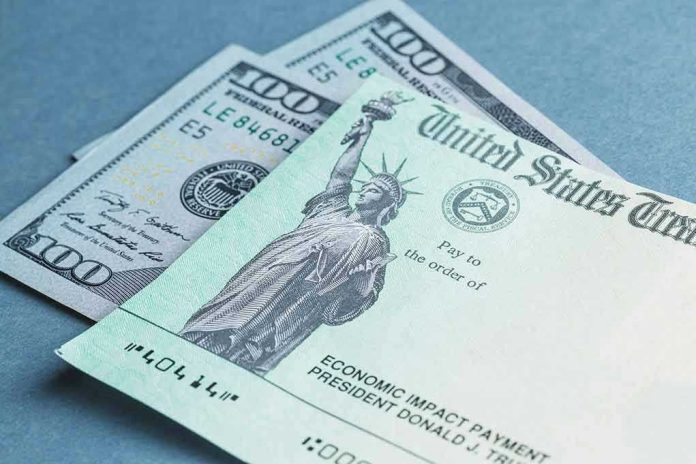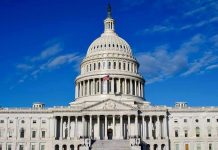
Trump’s promise to send every American $2,000 in mid-2026 funded by tariff revenue has ignited a political firestorm, but the math doesn’t add up and Congress hasn’t moved an inch.
Quick Take
- Trump and allies are actively lobbying Congress to approve $2,000 “tariff dividend” checks with a mid-2026 distribution target
- The proposal would cost approximately $450 billion, with no formal legislation introduced or federal agency confirmation as of November 2025
- Tariff revenue remains volatile and unreliable as a funding mechanism for large-scale direct payments
- Economic experts question feasibility while supporters frame it as a fair distribution of trade revenue to American citizens
The Campaign Promise That Defies Reality
When Trump announced his $2,000 tariff check plan, he positioned it as a revolutionary way to return trade revenue directly to Americans. Unlike traditional stimulus payments funded through federal borrowing or tax revenue, this proposal leverages tariff income collected from import duties. The timeline is specific: mid-2026. The amount is fixed: $2,000 per person. Yet the mechanism remains fundamentally unclear, and no congressional committee has drafted legislation to make it happen.
Congress Remains Silent While Allies Push Hard
Trump’s political machine has mobilized to pressure Congress into backing the initiative. Campaign surrogates and allied lawmakers are actively lobbying for support, framing the checks as a moral obligation to voters. However, congressional leadership has offered no official response or commitment. The deafening silence suggests serious reservations about the proposal’s viability. Without formal congressional action, the promise remains exactly what it is: a campaign talking point designed to energize voters heading into 2026.
The $450 Billion Problem Nobody’s Solving
Economic analysis reveals the staggering cost: approximately $450 billion to send $2,000 checks to every American. This figure assumes full distribution to the entire adult population. Tariff revenue fluctuates based on trade policy, global economic conditions, and import volumes. During Trump’s first administration, tariffs generated billions annually, but that income proved inconsistent and insufficient to fund such massive expenditures. Treasury Department officials have not confirmed whether tariff revenue could sustain this commitment without supplemental funding.
Tariff Revenue: A Shaky Foundation
The fundamental flaw in this proposal lies in its funding source. Tariff income depends on import activity, trade negotiations, and economic cycles. When imports decline, tariff revenue declines. When trade tensions ease, revenue drops further. Relying on this volatile stream to fund half a trillion dollars in direct payments represents extraordinary fiscal risk. Economic experts across the ideological spectrum have questioned whether tariffs alone could cover the full cost, let alone provide surplus revenue for other government operations.
No Federal Agency Has Confirmed Anything
As of November 2025, neither the Treasury Department, the Internal Revenue Service, nor any other federal agency has confirmed plans for a new stimulus program. No implementation framework exists. No distribution mechanism has been designed. No timeline for preparation has been established. The absence of agency involvement suggests the proposal remains purely political rhetoric rather than operational planning. Implementing such a program requires extensive preparation, coordination, and resource allocation that simply hasn’t begun.
Historical Precedent Offers Limited Guidance
The U.S. has issued direct payments before. The 2008 stimulus checks and three rounds of pandemic payments totaling up to $1,400 per person were funded through federal borrowing and tax revenue, not tariffs. Those programs faced their own logistical challenges and cost concerns. The tariff-funded approach represents uncharted territory, introducing additional complexity regarding revenue reliability and sustainability. Economic models for such a program simply don’t exist in modern American fiscal policy.
The Political Calculation Behind the Promise
Promising $2,000 to every American is politically potent, particularly in an election cycle. The specificity of the amount and timeline creates concrete expectations among voters. Trump’s allies understand that this proposal energizes supporters and differentiates his economic platform. However, political appeal and fiscal reality operate in different universes. The gap between campaign promise and governmental capability grows wider with each passing month that Congress takes no action and agencies remain silent.
What Would Actually Need to Happen
For this proposal to become reality, Congress must pass legislation authorizing the program, appropriating funds, and establishing implementation procedures. The Treasury Department would need to design distribution systems, verify eligibility, and coordinate with financial institutions. Economic projections would require validation. Tariff revenue would need to be formally designated for this purpose rather than general government operations. The legislative lift is substantial, and political opposition from fiscal conservatives and those skeptical of trade policies presents formidable obstacles.
Sources:
LiveNOW FOX: Tariff dividend: Trump says when he thinks checks would be issued
Axios: Trump’s $2,000 tariff checks would cost $450B, study says
AZCentral: When will the $2000 stimulus check come? Here’s what Trump says










